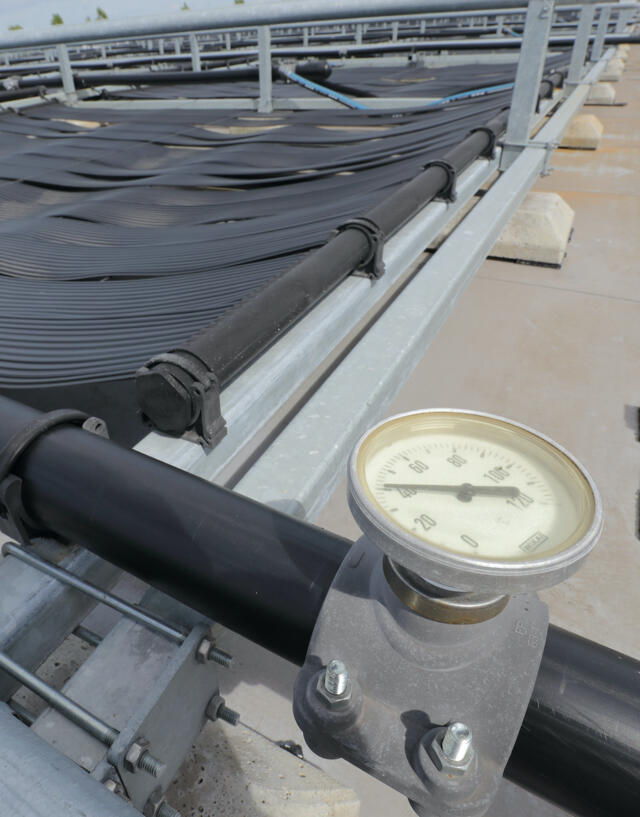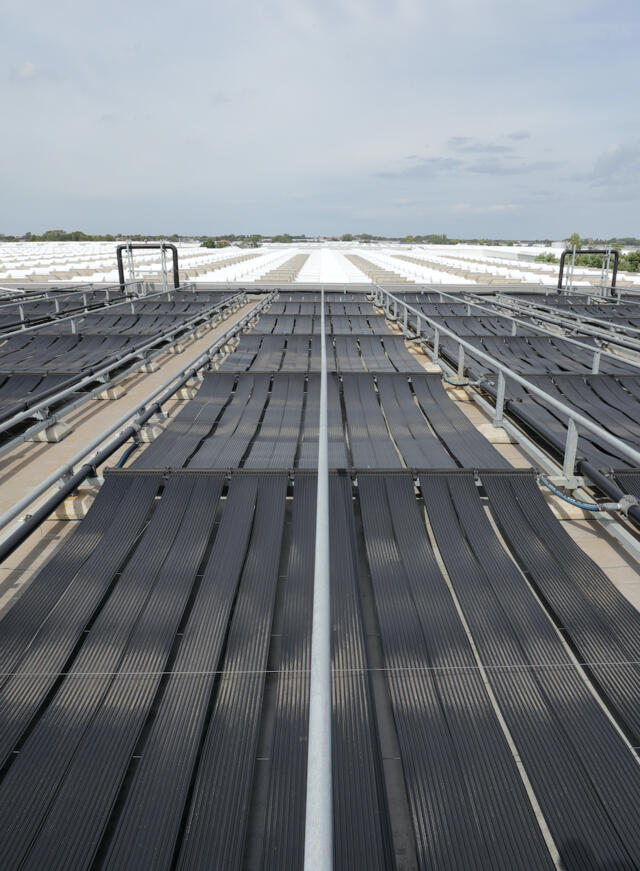
Solar-energy, but not in the way you think, Energy roof
The combination of circumstances at Koppert Cress made it possible to develop a unique system of solar collectors in collaboration with Bart van Meurs: the "energy roof".
Going through the roof, In the design phase
Heat and cold storage in the ground (ATES) is a great technique for using the heat extracted from a greenhouse in the summer to heat the same greenhouse in a sustainable manner in the winter. We have been using this technique to our satisfaction for years to reduce our dependence on fossil fuels. Thanks to the presence of our ATES, we were able to develop a unique system of solar collectors: the 'energy roof'.
In 2010 we built a new greenhouse and packaging area. For heating, we use the low-grade heat (<40°C) from our ATES. In the province of South Holland, where our greenhouses are located, the storage of heat in the soil is usually limited to a maximum of 25°C. However, in order to be able to use our sources even more efficiently, we received permission to inject up to 40°C through a Green Deal.
In order to make maximum use of our opportunities, we ran into two challenges. First of all, there was a heat deficit in the energy balance. A balance between extracted and injected energy is required for proper use of the ATES, both functionally and from the perspective of legislation and regulations. In addition, there were no sustainable sources of water at 40°C available in the company at the time the Green Deal was granted.
We urgently went looking for ways to store more heat in the sources in a sustainable way. Residual heat from the cooling cells was added to the installation and even the surface water adjacent to the company was regularly cooled. Still, the need for more (residual) heat remained.
The Koppert Cress processing area has an enormous flat roof, which was initially intended (and made heavier) for the installation of solar panels (solar PV). Due to the relatively low electricity prices and high investment, the business case for solar panels is relatively unattractive for large consumers. This freely available space gave us the idea of the 'energy roof'.

A rooftop pool, Made of tyleen
The water from the cold bubble in the ATES installation comes out of the ground at around 5 to 10°C and returns to the sources after the greenhouse has been cooled to a temperature of 18 to 25°C. "What if we fill the entire roof with tylene hoses and send the water through it?" "Wouldn't that make it possible to heat up our return water enormously?" A logical thought, but challenging in the technical implementation. However, the tone was set: "How can we use our roof with simple means to heat up our ATES?"
Literature research brought us, in addition to the well-known "high-quality" sheet and tube collectors, to roofing and asphalt with integrated collectors. However, roofing was already in place, making these solutions over-specified. In addition, the ambient temperature has a relatively high negative effect on the performance of these systems. The principle of a solar collector is simply that of a greenhouse: let the radiation in as much as possible and keep the cold out. This appealed to us as "horticultural entrepreneurs": "Can't we build small greenhouses on the roof?".
A practical equivalent to the many miles of tylene hose suggested are the plastic panels used in many Mediterranean countries to heat swimming pools. We decided to literally put this combination into practice behind the company: a small greenhouse containing the said panels. For comparison, we placed the same set of collectors next to it, without covering.
Despite the far from optimal conditions of this field trial, the principle has been amply proven. We were able to convert a significant portion (50%) of the solar radiation into heat. The roof ensured that the solar radiation could be properly harvested even at low temperatures.

The roof, the roof, The roof is on fire
The next step was to scale up the principle to a design that could be placed on our roof in a scalable and affordable way. We decided to focus on the greenhouse construction technology that we know so well.
After selecting materials, building prototypes and calculating weight and wind safety, we were able to get up the roof. We built an installation of approximately 2,000 m2 in 21 sections.
The 'energy roof' has been up and running since mid 2017. We are able to heat up the water at least 10°C and in this way have an extra capacity in the installation at our disposal that can reach up to 1 Megawatt. At the moment we are busy optimizing the control from the climate computer and fine-tuning the canopy of the sections, so that we can also harvest optimally in autumn.
We are taking a big step towards fossil-free cultivation in an original way with the 'energy roof'.